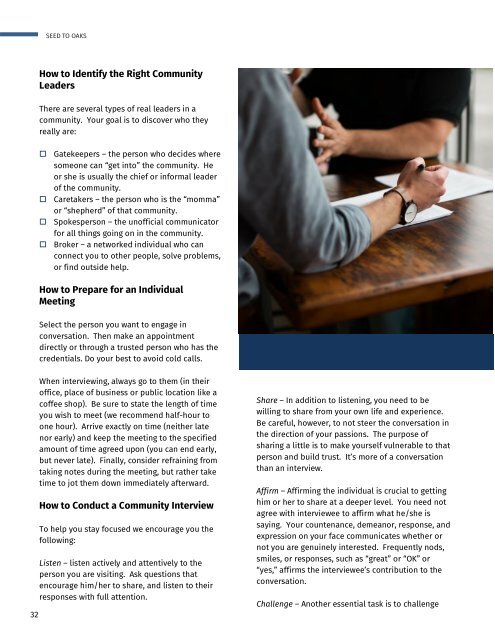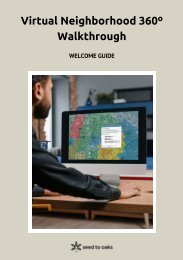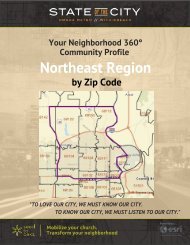You also want an ePaper? Increase the reach of your titles
YUMPU automatically turns print PDFs into web optimized ePapers that Google loves.
SEED TO OAKS<br />
How to Identify the Right <strong>Community</strong><br />
Leaders<br />
There are several types of real leaders in a<br />
community. Your goal is to discover who they<br />
really are:<br />
o Gatekeepers – the person who decides where<br />
someone can “get into” the community. He<br />
or she is usually the chief or informal leader<br />
of the community.<br />
o Caretakers – the person who is the “momma”<br />
or “shepherd” of that community.<br />
o Spokesperson – the unofficial communicator<br />
for all things going on in the community.<br />
o Broker – a networked individual who can<br />
connect you to other people, solve problems,<br />
or find outside help.<br />
How to Prepare for an Individual<br />
Meeting<br />
Select the person you want to engage in<br />
conversation. Then make an appointment<br />
directly or through a trusted person who has the<br />
credentials. Do your best to avoid cold calls.<br />
32<br />
When interviewing, always go to them (in their<br />
office, place of business or public location like a<br />
coffee shop). Be sure to state the length of time<br />
you wish to meet (we recommend half-hour to<br />
one hour). Arrive exactly on time (neither late<br />
nor early) and keep the meeting to the specified<br />
amount of time agreed upon (you can end early,<br />
but never late). Finally, consider refraining from<br />
taking notes during the meeting, but rather take<br />
time to jot them down immediately afterward.<br />
How to Conduct a <strong>Community</strong> Interview<br />
To help you stay focused we encourage you the<br />
following:<br />
Listen – listen actively and attentively to the<br />
person you are visiting. Ask questions that<br />
encourage him/her to share, and listen to their<br />
responses with full attention.<br />
Share – In addition to listening, you need to be<br />
willing to share from your own life and experience.<br />
Be careful, however, to not steer the conversation in<br />
the direction of your passions. The purpose of<br />
sharing a little is to make yourself vulnerable to that<br />
person and build trust. It’s more of a conversation<br />
than an interview.<br />
Affirm – Affirming the individual is crucial to getting<br />
him or her to share at a deeper level. You need not<br />
agree with interviewee to affirm what he/she is<br />
saying. Your countenance, demeanor, response, and<br />
expression on your face communicates whether or<br />
not you are genuinely interested. Frequently nods,<br />
smiles, or responses, such as “great” or “OK” or<br />
“yes,” affirms the interviewee’s contribution to the<br />
conversation.<br />
Challenge – Another essential task is to challenge


















